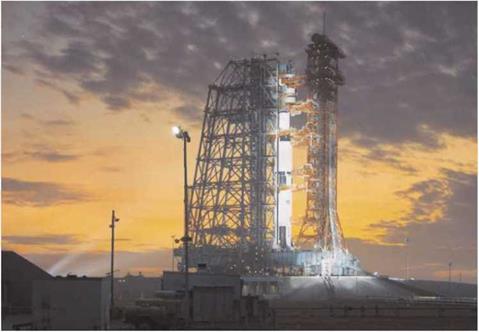At the pad
The soft-sounding term ‘launch pad’ belied the true nature of Pads A and В at Launch Complex 39. Each of these two massive, hard, angular structures consisted of a low concrete hill split in two by a trench whose base was level with the surrounding land, barely above sea level. This was to accommodate a wedge-shaped flame deflector of appropriately large dimensions that was wheeled beneath the rocket without descending below the local water table. The alignment of the trench ran along a line towards true north.
This was engineering audacity on an immense scale. The entire space vehicle with its launcher and transporter was substantially heavier than the Eiffel Tower. Yet all of its 8,400 tonnes were driven up a five per cent incline to the top of the 12-metre hill. As it climbed, the launcher was kept level by the crawler’s jacking system, which then gently set it down upon six piers astride the trench. After the crawler withdrew,
the flame deflector rolled beneath the cavity in the launch platfonn, ready to force the flames from the first – stage engines sideways along the trench in order to protect the vehicle from damage by reflected acoustic energy. All the surfaces directly facing the 1,500°C exhaust had to be lined with a suitable refractory material.
 Arranged around the pad’s central hill were ancillary buildings and equipment for storing and feeding propellants, gases, water and power to the vehicle, ponds for fuel spills, a hydrogen-burning pond and a network of roads.
Arranged around the pad’s central hill were ancillary buildings and equipment for storing and feeding propellants, gases, water and power to the vehicle, ponds for fuel spills, a hydrogen-burning pond and a network of roads.
Having installed the space vehicle on the pad, the crawler’s next task was to retrieve another huge tower from its parking site just off the crawlerway, and deliver it to the rocket. This mobile service structure (MSS) shielded the spacecraft from the weather and provided access all around it for final preparation. Weighing over 4,700 tonnes, this was yet another mobile engineering marvel among marvels.
The designers of the Apollo/Sa – turn launch facilities had been swept up in the optimism of the programme’s early days, when the Earth-orbit rendezvous method of getting to the Moon implied a much higher launch rate than was ever realised in operational use. Thus two pads were built with planning for a third having left a tell-tale kink in the crawlerway leading to Pad B. The complex had been designed to process as many as three stacks simultaneously. Pad В was actually only ever used once during the Apollo programme, for Apollo
10. This was during the very peak of
|
The mobile service structure tending the Apollo 8 space vehicle on Pad 39A. (NASA) |
activity, as the final push was being made for the Moon in 1969 and launches were occurring at bimonthly intervals.











